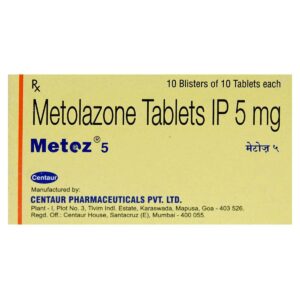METOLAZOLE
METOLAZOLE: Metolazone is a medication that belongs to the class of drugs known as thiazide-like diuretics. It is primarily used to treat conditions such as edema (fluid retention) and hypertension (high blood pressure).
The mechanism of action of metolazone involves its ability to inhibit the reabsorption of sodium and chloride ions in the kidneys. By doing so, it increases the excretion of water and salts in the urine, leading to diuresis (increased urine production). This diuretic effect helps to reduce fluid retention and lower blood pressure.
Metolazone is typically taken orally and is available in tablet form. The dosage will vary depending on the specific condition being treated and the individual’s medical history. The usual starting dose for edema is 2.5 to 5 mg once daily, while for hypertension it is 2.5 to 5 mg once daily or every other day. The dose may be adjusted by a healthcare professional as necessary.
As with any medication, metolazone can cause side effects. Common side effects include increased urination, dizziness, lightheadedness, headache, muscle cramps, and gastrointestinal disturbances such as nausea, vomiting, and diarrhea. These side effects are usually mild and transient.
Rare but more serious side effects may include low blood potassium levels (hypokalemia), low blood sodium levels (hyponatremia), allergic reactions, and kidney dysfunction. It is important to promptly report any unusual or severe side effects to a healthcare professional.
In summary, metolazone is a thiazide-like diuretic used to treat edema and hypertension. Its mechanism of action involves inhibiting the reabsorption of sodium and chloride ions in the kidneys. The dosage will vary depending on the condition being treated, and side effects may include increased urination, dizziness, and gastrointestinal disturbances. It is essential to follow the prescribed dosage and consult a healthcare professional for any concerns.

